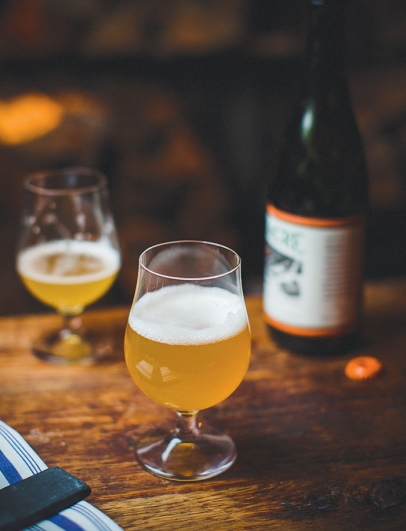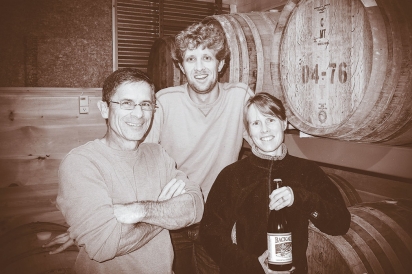Sourtooth: Backacre Beermakers Resurrects a Classic (with a Vermont Twist)
When I was 18, I lost my sense of smell. In the years since, my taste buds have gone on overdrive, clamoring for more—more salt, more spice and, most of all, more sour.
As a child, I’d popped Warheads and handfuls of Sour Patch Kids until my tongue went nearly numb from citric acid; as a (semi) adult, I turned to lime, tamarind, pickling brine, kombucha and, just recently, beer. At a bar in Carroll Gardens on the southern end of Brooklyn, I dubiously accepted a russet-colored sip from a stranger’s pint. I was not expecting a mouthful of tart, juicy cherry and musky wood, but I was very happy to get it.
The beer I tried is called kriek, and it is one of two refermented, peculiarly delicious offshoots of the lambic family. In and of itself, lambic stands apart from other beers because it is fermented with airborne wild yeasts and barrel-aged, both of which give it all sorts of dry, bright white-wine-y notes.
Lambic’s other refermented offshoot is gueuze, a beer that sounds like a sneeze, smells like a barn, and tastes like … any number of things, most of them sour. Like a mule, it is sturdy and intelligent and can only be created from existing creatures. The “oude”-style gueuze, so-called because it is not artificially sweetened, is slowly coming back into favor in its home country, but stateside it is even harder to come by than kriek.
Which is a pity, because, to us sourtooths, it is singularly delicious. To sample it, you can order a case from Belgium, or you can drive to south-central Vermont, where a handful of restaurants and liquor stores stock green 750ml bottles of Backacre Brewery’s Sour Golden Ale.
The raven on Sour Golden Ale’s label overlooks snowy fields and a snug wood farmhouse—about as quintessentially Vermont a scene as any. But Backacre’s genesis really began in Belgium, where Matt Baumgart and Erin Donovan lived for two years. The couple had been enthusiastic home brewers in Denver. They went to Belgium, Matt says, “not just to drink beer, but we certainly drank a lot of it.”
In Belgium, Matt and Erin noticed that people out at bars would “start with a pilsner, then have an iced tea, then a specialty beer, then another iced tea. They drink slower, last longer and don’t get super drunk.”
Drink slower, last longer, don’t get too drunk: It’s a drinking culture that begs for beers that are as refreshing as they are interesting. Gueuze has both qualities in spades; before long, Matt and Erin were hooked. In particular, they were taken with Hanssens, a blendery in Dworp that has been blending and bottling small batches of gueuze since 1871. In fact, some of its barrels are over a century old.
“We were inspired by the fact that this kind of beer doesn’t need babysitting. It’s not a fulltime thing; people who were running it had day jobs. There’s really nothing for you to do except not screw it up,” says Matt.
The way gueuze is made is one of its wonderful aspects, along with its taste. The process begins with brewing the lambic, which like any beer, starts with wort—a mix of malted barley, wheat and water, filtered into a clear brown liquid that tastes, Matt says, like “sweet cereal syrup.” The brewer takes the unfermented wort to a blendery—so called because only the aging and blending of beer takes place there. At the blendery, the wort is inoculated with wild yeasts, and aged in a wood barrel.
A year or more later, you have lambic. To make gueuze, the young lambic is blended with other, older barrels before the final bottling. Watching the process at Hanssens got Matt and Erin thinking they might be able to replicate it. There was even a barn waiting for them in Vermont—“why not put some casks in [it]?”
The barn belongs to Erin’s parents. In their pre-Backacre days, the couple would fly in from Denver for the holidays and find themselves with a surfeit of time. Now they had something to fill it with. The first batch of wort went into a barrel in 2011; two years later, Backacre released its first batch of Sour Golden Ale.
As at Hanssens, the beermaking at Backacre is a communal affair: A local brewer contributes the wort, Erin’s father handles deliveries and daily check-ins, and Matt and Erin oversee the blending and bottling. However, Backacre’s fermentation process differs from Hanssens: While their wort also goes into oak barrels, Backacre doesn’t not leave the yeast inoculation completely up to Mother Nature. Before the wort is added, the barrels are inoculated with yeast strains which have been carefully selected by Matt and Erin. “We grew the organisms up and selected the ones we like,” Matt explains.
So, there is a bit of biochemistry, of mad science, in Backacre Beer. But mostly, there is time, and patience, and then, a year or so later, a lot of tasting to determine which of the older barrels play well with their newest sibling, and in what quantities.
“When we blend, we’re not looking to match the flavor of last time. We taste from all the barrels each time we blend and try to figure out the best blend we can make on that day. We’re looking more to try to balance—sometimes barrels have a lot of wild yeast character, a lot of bitter, a lot of sour,” Matt says.
So far, there have been three releases of Backacre. The most recent, a mix of 1-, 2- and 3-year-old beers, shares its predecessors’ tart champagne-cider backbone, but the alcohol content’s been toned down and the dry oak/apple/stone-fruit flavors from the barrel sing a little louder. (In their previous lives, Backacre’s barrels held Napa whites; while most of Sour Golden Ale’s flavor comes from the wood, there is a smattering of high, citrusy shoutouts to Sauvignon Blanc.)
On their website, Matt and Erin suggest pairing Backacre with an “open-faced sandwich of cream cheese, radish and red onion.” I had my first pint with a cheeseburger that I don’t remember because I was too busy obsessing over tart funky-tanginess. Much like cider, Sour Golden Ale is cloudy, but it has beer’s foamy head and irregular bubbles. It would, I think, go very nicely with a local cheddar—but first you’ll have to find some Backacre. Restaurants including the Downtown Grocery in Ludlow and Three Penny Tap Room in Montpelier stock the gueuze, but not in great quantities, and it sells like gangbusters.
“We’re expanding as fast as we can but that’s not very fast. We’ve doubled the number of barrels but there is such a long turnaround,” Matt says.
My advice: Look early, look often and, when you do find it, drink slowly.
To find out more visit BackacreBeermakers.com.
Pair It Up
While Sour Golden Ale is lovely on its own, it’s remarkably versatile with food—particularly winter’s heartier, more luxurious dishes. As with wine, you can pair this ale with contrasting flavors (sweet, rich) or complementing flavors (funky, sour). Here are a few of my favorites:
Salad: Caprese, Greek or a simple green salad tossed with balsamic vinaigrette.
Seafood: Crab cakes, bluefish or mussels (for the latter, do as the Belgians and steam them in a bit of the sour ale).
Meats: Pâté (venison is especially nice, but pork is great as well), duck confit, cassoulet.
Cheese: Bleu cheeses love sour beers, as does the runnier end of the barnyard, including Epoisses, Taleggio and Stinking Bishop. If you like a bit of jam with your stinkies, try fig—or marmalade.
Dessert: Broiled grapefruit, tiramisu or a dense chocolate cake (use dark, high-quality chocolate—Scharffen Berger makes a good one).





